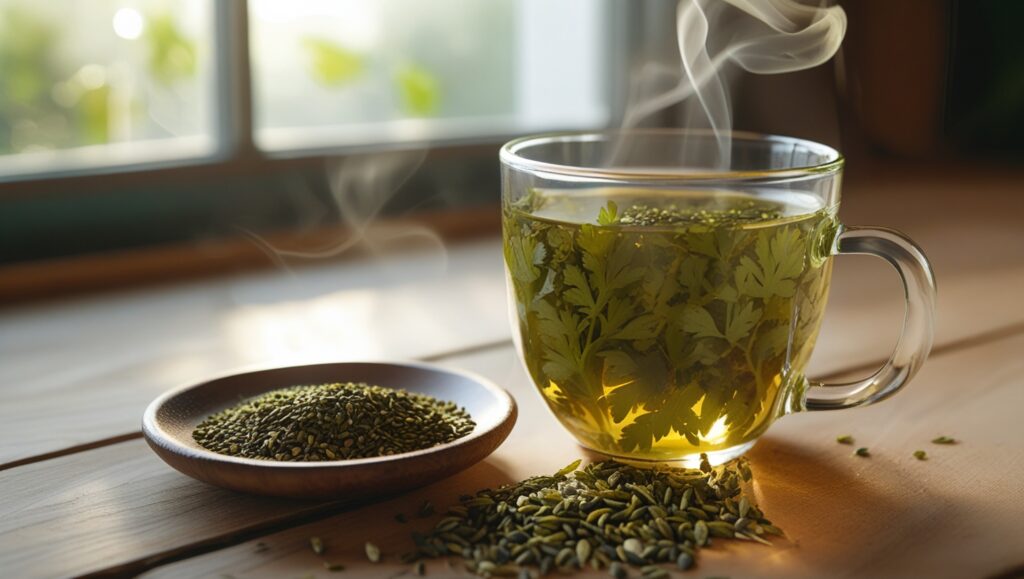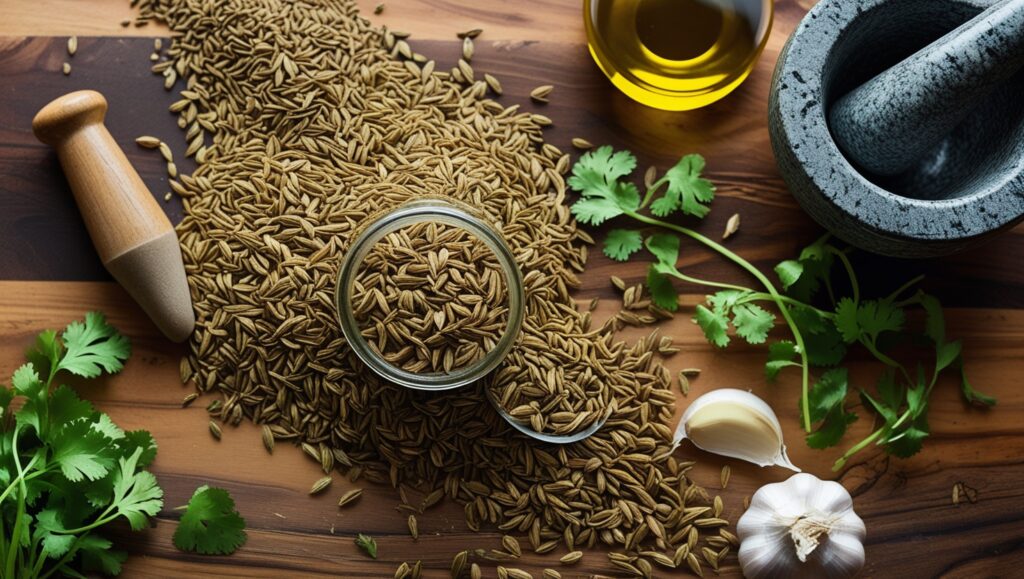Here’s a little secret that I haven’t been keeping: the coriander seeds quietly adopted my spice shelf. Yes, these small, beige, crispy little bowls, most of us come in cooking gear.
I didn’t know that all the time. Coriander seeds were so boring to unexpectedly chew with biryani, and I quickly regretted it. However, I roasted one teaspoon of them and crushed them onto a roasted roast of warm vegetables. What are the reasons why you’re getting a permanent seat within the Inner Kitchen Series?
A Bit About the Basics: What Are Coriander Seeds, Anyway?
When they are new, the cilantro seeds are dried fruits (yeah, technically speaking, fruit!) and the coriandrum sativum plant. The same plant also gives coriander, the green part of the leaves. However, there are no such things as coriander seeds or coriander. Coriander is brave and male, but coriander seeds are warm, quoted, and slightly nutty.
Spice World Origins: A Journey Across Continents
Coriander was there forever, like the Egyptian Pharaoh. It was discovered in Old Graves, and has a biblical cameo that has grown everywhere from India and Morocco to South America. Yes, there are more frequent flyers than I am.
Popularity in Indian, National Eastern, Latin American, and Southeast Asian cuisine probably means that you’ve already tried it without knowing it. Have you ever had a completely experienced tacos or a deep, fragrant curry? Coriander seeds probably had hands (or seeds).
The Flavor Glow-Up: Roasting Is Everything
Here’s my number one coriander tip: roast those babies.
Seriously, throw the spoon into a dry pan over medium heat and watch the magic. They burst a bit, turn a rich brown, and suddenly smell the smell of someone who knows exactly what they’re doing. Once cooled, crush it into a mortar and pestle or spice mill. From salad dressings to roasted potatoes, if you add it to everything, there’s a taste that no one is ready for.
Coriander Seeds vs. Ground Coriander: Not the Same Vibe
I used to think, “Why buy the seeds when I can just get the powder?” And I get it—convenience is king. But the seeds have a different kind of magic. They hold their oils (and therefore their flavor) way better. Grinding them fresh gives you a spice that’s just… brighter. More alive.
Ground coriander loses its mojo fast. So if you’re using the powdered stuff from that jar you opened in 2018, we need to talk.
Health Vibes: Not Just a Pretty Taste
Okay, I’m not a doctor, but coriander seeds come with some impressive health benefits that have science (and centuries of traditional use) behind them.
- Digestive delight: They’re known to ease bloating and gas. (Can confirm from experience—TMI, but real.)
- Anti-inflammatory properties: Great for joint support and general inflammation.
- Blood sugar regulation: Some studies say coriander can help manage blood sugar. Worth chatting with your doc if you’re curious!
- Rich in antioxidants: Basically, they help fight the bad guys in your body.
DIY Coriander Tea: A Cozy Little Wellness Ritual
This is my rainy day go-to: boil a teaspoon of crushed coriander seeds in water for 5-7 minutes. Strain, add honey or lemon if you’re feeling fancy, and sip slowly. It’s warm, earthy, and surprisingly calming. Great for digestion after a big meal or when you’ve got that annoying bloated feeling.
My Favorite Ways to Use Coriander Seeds (Besides Staring at Them Lovingly)
- Pickling: They add a little zing to pickled onions, carrots, or cucumbers.
- Spice rubs: Combine crushed coriander with cumin, paprika, and garlic powder for next-level grilled chicken or tofu.
- Rice dishes: Toss a few whole seeds in your rice as it cooks.
- Baking?! Yep. I’ve made sourdough with crushed coriander in the dough. Subtle, citrusy magic.

Storing and Freshness Tips: Don’t Let Good Seeds Go Bad
Buy them whole and store them in a cool, dark spot in an airtight jar. They’ll keep their flavor for about a year (but let’s be honest—you’ll use them all before then). Avoid storing them above the stove or near heat. That’s a spice graveyard.
Fun Fact Interlude: Did You Know?
- Coriander is one of the oldest known spices.
- In some parts of Europe, coriander seeds are coated in sugar and eaten as candy.
- The name “coriander” comes from the Greek word koriannon, which meant “bedbug.” (Don’t worry—it doesn’t taste like one.)
The Cilantro Controversy: Team Leaves vs. Team Seeds
Cilantro (the leaves) is weirdly polarizing—some folks think it tastes like soap. If you’re in that group, don’t worry: coriander seeds taste completely different. It’s like comparing coffee beans to espresso martinis.
Can You Grow Coriander Seeds at Home?
Short answer: heck yes.
Plant the cilantro seeds in a sunny place, water them regularly, and quickly have fresh cilantro and eventually more seeds. Leave the plant’s flowers and bolts, and collect the seeds when they are dried. It’s a kind of pantry moment.
For the Flavor Nerds: Pairing Coriander with Other Spices
Coriander seeds play well with:
- Cumin (match made in curry heaven)
- Fennel (especially in sausage or chai blends)
- Cardamom (sweet, citrusy synergy)
- Black pepper (adds heat to the mellow)
The spice blend possibilities are endless. Try mixing and matching to find your favorite combo.
Kitchen Hack: Coriander Oil
Infuse some coriander seeds in olive oil over low heat for 20-30 minutes. Strain and store. Use on roasted veggies, in marinades, or drizzled over hummus. You’re welcome.
When NOT to Use Coriander Seeds
Okay, real talk: coriander doesn’t belong in every dish. Don’t toss it in spaghetti or mac and cheese unless you’re on a very specific flavor journey. Use your spice intuition.
My Takeaway: A Tiny Seed with Big Personality
Coriander seeds are probably small, however, they’re mighty. They’ve taught me that high-quality taste doesn`t have to come from complex substances or fancy techniques. Sometimes, all it takes is a tiny seed, a touch of heat, and a curious spirit.
If you’ve in no way cooked with them before, give it a try. And in case you have, try using them in a new way. Whether you’re creating a comfortable cup of tea or raising a weeknight dinner, coriander seeds have got your back.
Thanks for stopping by! Let me recognise within the feedback how you operate coriander seeds—or in case you`ve been sleeping on all of them this time.
FAQs
1. Can I use coriander seeds in sweet dishes?
Absolutely! Try adding a pinch of crushed coriander to cookies, bread, or even granola for a citrusy twist.
2. Are coriander seeds and cumin the same thing?
Nope. They look similar when ground, but cumin has a smokier, earthier flavor while coriander is more citrusy and nutty.
3. Do I need a spice grinder to use coriander seeds?
Not necessarily. A mortar and pestle or even the back of a spoon can do the trick. Get creative!
4. Are there any side effects to coriander seeds?
Generally safe in normal amounts, but always best to check with a healthcare provider if you’re pregnant or on medication.
5. Can I substitute ground coriander for coriander seeds?
You can, but the flavor won’t be as vibrant. If possible, toast and grind the seeds fresh for optimal results.
